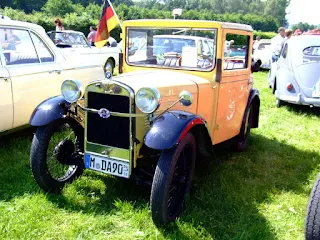In 1927, Fahrzeugfabrik Eisenach, which manufactured automobiles under the Dixi marque, entered a contract with the Austin Motor Company to manufacture the Austin Seven under licence. The first fifty Eisenach-built Sevens were right-hand-drive cars assembled in September 1927 from parts provided by Austin's factory in Longbridge. By December 1927, Dixi had begun building their version of the Seven, the left-hand-drive Dixi 3/15 PS DA-1, built from parts made by Dixi. The 3/15 designation was derived from a taxable horsepower rating of 3 PS with an actual power output of approximately 15 PS (11 kW; 15 hp) The DA-1 designation stood for Erste Deutsche Ausführung (First German Version)
The main differences between the BMW Dixi 3/15 DA-1 and the contemporary Austin Seven were the addition of Bosch shock absorbers, the placement of the driver's controls on the left side of the vehicle, and the use of metric fasteners.
Top speed: 75 km/h (45 mph)
Acceleration 8 to 40 km/h (5 to 25 mph): 10 seconds
Fuel consumption: appr. 5.5 L/100 km (51 mpg‑imp; 43 mpg‑US)
BMW bought Fahrzeugfabrik Eisenach from parent company Gothaer Waggonfabrik in October 1928. As a result, the Dixi 3/15 PS DA-1, when upgraded for 1929 became the BMW Dixi 3/15 DA-2 or, increasingly, simply as the BMW 3/15 DA-2
The 3/15 DA-2 replaced the DA-1 in April 1929. The main change from the DA-1 was the operation of the foot brakes, controlled via cable linkage, now acting on all four wheels: brakes on the DA-1 had operated only the rear wheels. Other changes included larger tyres and a lower final drive ratio. There was no change in either the size or the claimed output and performance from the car's four cylinder four-stroke side-valve engine.
Available body styles included a steel-bodied two-door saloon, a two-seat convertible, and a delivery van.
The main differences between the BMW Dixi 3/15 DA-1 and the contemporary Austin Seven were the addition of Bosch shock absorbers, the placement of the driver's controls on the left side of the vehicle, and the use of metric fasteners.
Top speed: 75 km/h (45 mph)
Acceleration 8 to 40 km/h (5 to 25 mph): 10 seconds
Fuel consumption: appr. 5.5 L/100 km (51 mpg‑imp; 43 mpg‑US)
BMW bought Fahrzeugfabrik Eisenach from parent company Gothaer Waggonfabrik in October 1928. As a result, the Dixi 3/15 PS DA-1, when upgraded for 1929 became the BMW Dixi 3/15 DA-2 or, increasingly, simply as the BMW 3/15 DA-2
The 3/15 DA-2 replaced the DA-1 in April 1929. The main change from the DA-1 was the operation of the foot brakes, controlled via cable linkage, now acting on all four wheels: brakes on the DA-1 had operated only the rear wheels. Other changes included larger tyres and a lower final drive ratio. There was no change in either the size or the claimed output and performance from the car's four cylinder four-stroke side-valve engine.
Available body styles included a steel-bodied two-door saloon, a two-seat convertible, and a delivery van.









.jfif)




No comments:
Post a Comment